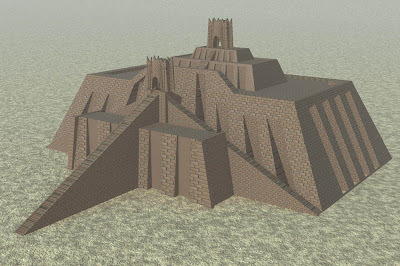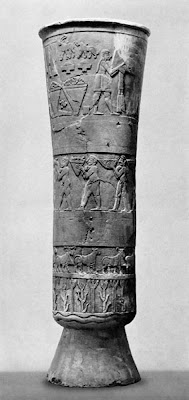The Ziggurat
Ziggurat of Ur (ca 2100 BCE), Tell Muqqayar, Iraq
source: Wikipedia
The question of the origins and function of the ziggurat is still a matter of controversy among the specialists. Whether the raised structure served the practical aim of protection against floods, or whether the platforms served primarily as a place for the deities with a shrine, that is, a place to house the god or goddess, located on the top and, therefore, it served as a way of contact and communication with the celestial gods, is a matter of debates. What seems to be certain is that its form, after a more or less extended period of development, was consolidated in Ur, and disseminated afterwards in the Mesopotamian area across time and across cultures.
The idea that the form of the ziggurat evolved from the ritual destruction and reconstruction of existing structures which served as foundations for new constructions that were, in this manner, systematically and progressively raised higher and higher, has been proposed (based also on examples from Neolithic practices, Meso-American cultures and also Egypt) and rejected by researchers. As well as different interpretations of its symbolic meaning.
The ziggurat is a kind of artificial mountain emerging in the Mesopotamian flatlands. It was part of an architectural complex that may have included also, among other structures, temples and other public buildings, different civic and commercial spaces, etc. Access to the ziggurat was probably restricted and controlled as a space for the performance of specific rituals under the direction of priests.
In its architectural form, size, technological aspects, labor force organization and employment, the ziggurat embodied and expressed the unified and unifying power of new social-historical structures. It expressed the profound identity of worldly and sacred powers, the unity of religion and politics which characterized the ideology proper to the initial forms of the State that emerged as functional specialization, and related social stratification processes and structures developed and were consolidated in the city-states of Mesopotamia: from more or less humble beginnings to its culmination and diffusion in the pioneer civilization of the Sumerians.
The Sumerians, as we know, established the early cultural matrix, including writing and literature, architecture and the arts, religion, political forms and ideologies, etc pointing the way to many of the essential future developments in the region. The ziggurat and White Temple at Uruk (ca. 3200-3000 BCE) and the partially reconstructed large ziggurat of Ur ( ca 2100 BCE) are two examples of the accomplishments of the Sumerians in architecture.
A famous ziggurat in the Ancient World was the monumental Etemenanki ("temple of the foundation of heaven and earth") dedicated to the god Marduk in Babylon in the 6th century BCE, the period of the Neo-Babylonian dynasty. It is associated with the biblical narrative of the Tower of Babel
Marcelo Guimaraes Lima
The idea that the form of the ziggurat evolved from the ritual destruction and reconstruction of existing structures which served as foundations for new constructions that were, in this manner, systematically and progressively raised higher and higher, has been proposed (based also on examples from Neolithic practices, Meso-American cultures and also Egypt) and rejected by researchers. As well as different interpretations of its symbolic meaning.
The ziggurat is a kind of artificial mountain emerging in the Mesopotamian flatlands. It was part of an architectural complex that may have included also, among other structures, temples and other public buildings, different civic and commercial spaces, etc. Access to the ziggurat was probably restricted and controlled as a space for the performance of specific rituals under the direction of priests.
In its architectural form, size, technological aspects, labor force organization and employment, the ziggurat embodied and expressed the unified and unifying power of new social-historical structures. It expressed the profound identity of worldly and sacred powers, the unity of religion and politics which characterized the ideology proper to the initial forms of the State that emerged as functional specialization, and related social stratification processes and structures developed and were consolidated in the city-states of Mesopotamia: from more or less humble beginnings to its culmination and diffusion in the pioneer civilization of the Sumerians.
The Sumerians, as we know, established the early cultural matrix, including writing and literature, architecture and the arts, religion, political forms and ideologies, etc pointing the way to many of the essential future developments in the region. The ziggurat and White Temple at Uruk (ca. 3200-3000 BCE) and the partially reconstructed large ziggurat of Ur ( ca 2100 BCE) are two examples of the accomplishments of the Sumerians in architecture.
A famous ziggurat in the Ancient World was the monumental Etemenanki ("temple of the foundation of heaven and earth") dedicated to the god Marduk in Babylon in the 6th century BCE, the period of the Neo-Babylonian dynasty. It is associated with the biblical narrative of the Tower of Babel
Marcelo Guimaraes Lima
Reconstruction of Ur-Nammu's ziggurat,
based on the 1939 reconstruction by Woolley (vol. V, fig. 1.4)
based on the 1939 reconstruction by Woolley (vol. V, fig. 1.4)
source: Wikipedia
Ruins of White Temple at Uruk, Iraq
source: http://people.wku.edu/darlene.applegate/oldworld/webnotes/3neareast/civ.html#warka
Reconstruction of Etemenanki, based on
Hansjörg Schmid, Der Tempelturm Etemenanki in Babylon (1995 Mainz)
Hansjörg Schmid, Der Tempelturm Etemenanki in Babylon (1995 Mainz)
source: Wikipedia






Comments